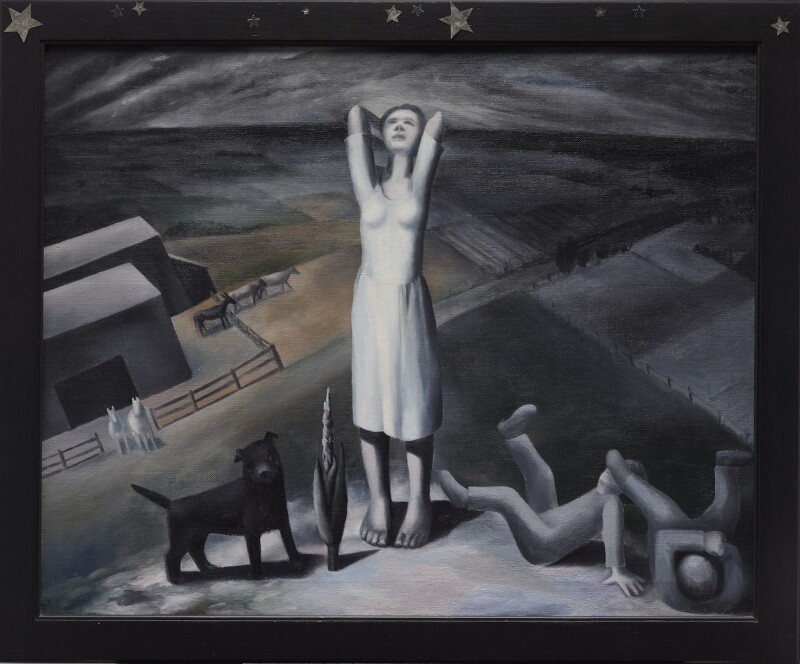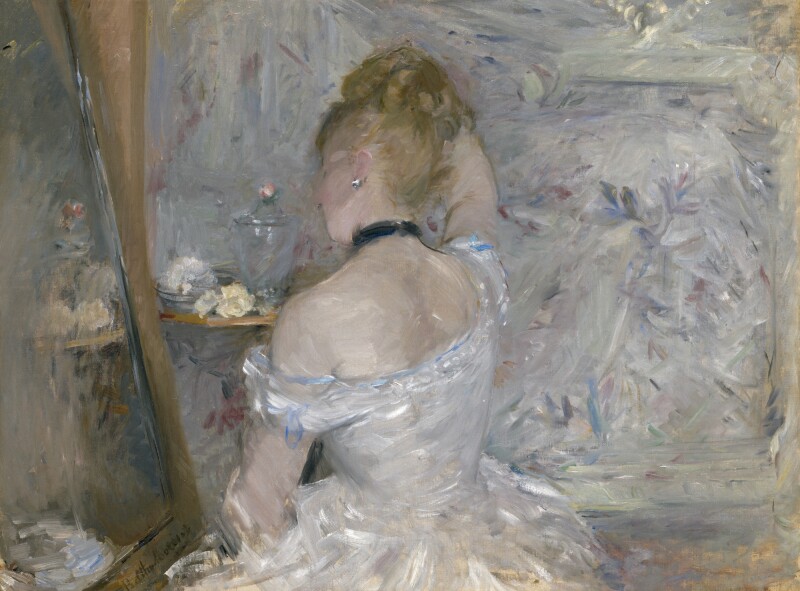Whether retrospectives on unsung creators, or group shows exploring the justice system and conspiracy, U.S. museums this fall are broadening visitor perspectives on historic and contemporary art.
A folk artist whose art went overlooked in life gets a major posthumous tribute, while the sister of one of the 20th century’s most famous artists finally receives her limelight.
Here are 10 exhibitions worth making a destination for fall travel.

Bill Traylor, “Man in Black and Blue with Cigar and Suitcase” (1939–42)
Photo by Matt Flynn, © Smithsonian Institution
Between Worlds: The Art of Bill Traylor
September 28, 2018–March 17, 2019; Smithsonian American Art Museum, Washington, D.C.
Bill Traylor was born into slavery in 1853, subsequently living through the Civil War, the Emancipation Proclamation, and the Jim Crow segregation that followed in his home state of Alabama.
Only after he became too old for his work as a sharecropper did he turn to art, but his energy for it was boundless, with more than 1,000 drawings and paintings completed before his death in 1949. With scenes of black city and rural life, rendered in dynamic silhouettes sketched on pieces of cardboard and paper he found around Montgomery, his exuberant art garnered mainstream attention following his death.
Now he’s among the most well-known of American folk artists, and the Smithsonian American Art Museum is celebrating that legacy in this comprehensive retrospective.
Art for a New Understanding: Native Voices, 1950s to Now
October 6, 2018–January 7, 2019; Crystal Bridges Museum of American Art, Bentonville, Arkansas
Through 75 pieces, this exhibition at Crystal Bridges argues for the influence on 20th-century art by Indigenous artists, even while their work is too often considered outside the mainstream. Focusing on the United States and Canada, Art for a New Understanding features artists such as Fritz Scholder, Edgar Heap of Birds, Kay WalkingStick, and Carl Beam, with diverse media, including painting, performance, sound, photography, and video.
From Shan Goshorn’s Removal (Ancestral Homeland and Oklahoma Indian Territory)—baskets with shreds of the Indian Removal Act of 1830 embedded in their traditional Cherokee double-ware weave—to Kent Monkman’s History Is Painted by the Victors that infiltrates an Albert Bierstadt landscape with figures like a woman painting the Battle of the Little Bighorn, each is a distinct statement on Indigenous identity and representation in art.

Ida Ten Eyck O’Keeffe, “Star Gazing in Texas” (1938)
Courtesy of Dallas Museum of Art, General Acquisitions Fund and Janet Kendall Forsythe Fund in honor of Janet Kendall Forsythe on behalf of the Earl A. Forsythe family
Ida O’Keeffe: Escaping Georgia’s Shadow
November 18, 2018–February 24, 2019; Dallas Museum of Art, Dallas, Texas
Georgia O’Keeffe is among the most famous U.S. artists, yet few know that she had a sister who was also a professional painter. Long overshadowed through her relationship and rivalry with her older sibling, Ida Ten Eyck O’Keeffe is finally getting a major exhibition.
Around 40 of her paintings, watercolors, drawings, and prints are being reunited at the Dallas Museum of Art, showing how she engaged with both modernism and regionalism in the early to mid-20th century. One painting series meditates on an increasingly abstracted lighthouse, and another work (above) has an enigmatic scene of a woman stargazing in Texas, all revealing the vivid color and compositions of this lesser known, but also talented, O’Keeffe.
Stones to Stains: The Drawings of Victor Hugo
September 27–December 30, 2018; Hammer Museum, Los Angeles, California
Amid writing the colossal 19th-century novels Les Misérables and The Hunchback of Notre-Dame, as well as numerous poems and plays, Victor Hugo somehow found time to create thousands of drawings.
This exhibition at the Hammer Museum features over 75 drawings and photographs from throughout the French author’s career, showing how he was not just an adept draftsman, but also experimental in his art. Sometimes he would depict ruins, waves, or strange landscapes in ink and wash; other times, he would let the ink pool and spill into murky forms.
With loans from the Bibliothèque nationale de France and the Maisons de Victor Hugo, this is a rare opportunity to examine a side of Hugo’s work that was little seen even in his lifetime.
Live/Work
August 5, 2018–March 3, 2019; John Michael Kohler Arts Center, Sheboygan, Wisconsin
The John Michael Kohler Arts Center has a unique focus on artist-built environments, and this series of four exhibitions looks at one of the most important creative spaces: the studio. In Makeshift, site-specific installations by such artists as Trenton Doyle Hancock, Brad Kahlhamer, and Alison Elizabeth Taylor visualize the vitality of the studio in their practices, while a showcase of pieces by Garry Noland and Peggy Noland explores how the father and daughter collaborate on their processes.
Elaborate sculptures by Joel Otterson, their hardwoods and plush upholstery fabrics joined by tapestries sewn at his studio, and Virgil Marti’s exhibition of his work with influential objects from his studio further testify to the studio as a space for inspiration and innovation.
Ruth Asawa: Life’s Work
September 14, 2018–February 16, 2019; Pulitzer Arts Foundation, St. Louis, Missouri
Ruth Asawa, who died in 2013, wove metal into suspended sculptures that cast curving shadows. Despite working primarily in metal, her objects of line and shape have a visual lightness. This career survey at the Pulitzer Arts Foundation includes around 60 sculptures.
As a Japanese American artist, she faced discrimination after World War II in her career and education; as a woman, her work was often dismissed as domestic or decorative. Joining the sculptures with her drawings and collages, Life’s Work affirms her place as an innovator of postwar abstraction.

Emory Douglas, “The Black Panther (back cover), September 21, 1974 (I Gerald Ford am the 38th Puppet of the United States).”
© 2018 Emory Douglas/Artists Rights Society (ARS), New York
Everything Is Connected: Art and Conspiracy
September 18, 2018–January 6, 2019; Met Breuer, New York City
From the moon landing to Watergate to 9/11, the decades between 1969 and 2016 have been ripe for conspiracy, based both on fact and fantasy. This exhibition at the Met Breuer explores how 30 artists have addressed conspiracy, including Raymond Pettibon, Sue Williams, Jim Shaw, Jenny Holzer, and Emory Douglas.
It highlights how these postwar artists infused movements such as pop art and conceptualism—frequently viewed as nonpolitical—with critiques of democracy, corporate fraud, and espionage. The exhibition is divided into two sections, with one on how artists have uncovered evidence of deceit in nefarious areas like shell corporations or arms dealing. The second probes how artists have used visuals of the fantastic to suggest the truths hidden by power.

Jason Moran, “Slugs’ Saloon” (2018)
Courtesy of the artist and Luhring Augustine, New York, photo by Farzad Owrang, © Jason Moran
Jason Moran
September 19, 2018–January 21, 2019; Institute of Contemporary Art/Boston, Boston, Massachusetts
Slugs’ Saloon was a jazz hub of New York’s Lower East Side from the mid-1960s until it was shuttered in early 1970s, hosting progressive musicians like Charles Mingus and Sun Ra. Now some of that history is resurrected in Jason Moran’s latest installation, complete with a recreated stretch of the dive’s sawdust floor.
It’s joined at the ICA Boston by two of the artist and pianist’s earlier sculptural tributes to late jazz clubs—the Savoy Ballroom and Three Deuces—which debuted at the 2015 Venice Biennale, as well as his charcoal drawings and multimedia work. The exhibition, which originated at the Walker Art Center in Minneapolis, will regularly be activated by performances in the galleries, adding the sonic heritage to these monuments for lost landmarks of music.
Walls Turned Sideways: Artists Confront the Justice System
August 25, 2018–January 6, 2019; Contemporary Arts Museum Houston, Houston, Texas
This exhibition at the Contemporary Arts Museum Houston spans four decades and includes artists from across the United States who have addressed the criminal justice system. By bringing visibility to mass incarceration and the prison industrial complex, they show how artists can have an activist role in dismantling these institutions.
For instance, Josh Begley’s Prison Map is an online catalogue of aerial photography of prisons, jails, and detention centers that gives an architectural scale to the prison system, while Dread Scott’s Wanted street art posters have sketches of black and Latino youth with their “crimes” of everyday behavior that have drawn police harassment.

Berthe Morisot, “Woman at Her Toilette” (1875–80)
Courtesy of the Art Institute of Chicago/Art Resource, NY
Berthe Morisot: Woman Impressionist
October 21, 2018–January 14, 2019; Barnes Foundation, Philadelphia, Pennsylvania
Berthe Morisot was a leading Parisian artist of impressionism, but she isn’t a household name like her male contemporaries Edgar Degas or Claude Monet. This major traveling exhibition, organized by the Barnes Foundation, the Musée national des beaux-arts du Québec, the Dallas Museum of Art, and the Musées d’Orsay et de l’Orangerie, aims to bring her dynamic art more acclaim.
The retrospective of about 70 works concentrates on her portraiture and figure paintings, exploring how the unfinished appearance of her paintings, with the visible brushstrokes and sketch-like style, gives her work a dynamic immediacy. Meanwhile, her depictions of women’s fashion and domestic tasks demonstrate her intimate perspective on expectations for female identity in both public and private space in the 19th century.
>> Next: This Former Prison Is Hong Kong’s Best New Arts Hub











